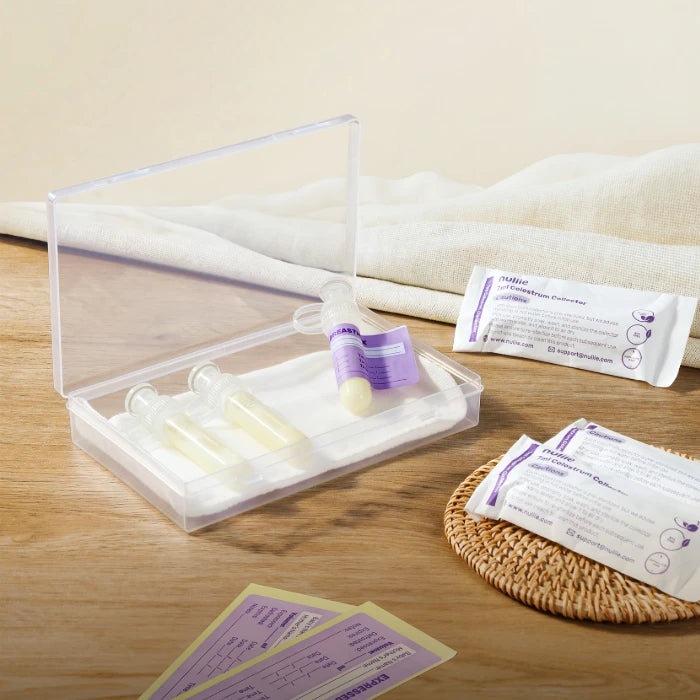Breastfeeding is rewarding, but storing breast milk can be challenging. Whether returning to work, traveling, or building a stash, it's crucial to know the best storage practices. This guide covers how long milk lasts, how to keep it fresh, and ensure it's safe for your baby.
1. Safe Time Frames for Breast Milk at Different Temperatures
One of the most common questions breastfeeding moms ask is, “How long does breast milk last?” The answer depends on how the milk is stored. Whether you leave it at room temperature, refrigerate it, or freeze it, each storage method comes with its own time frame for keeping the milk safe and fresh.
- Storing at Room Temperature
Breast milk can last for about 4 hours at room temperature, typically up to 77°F (25°C). This is the most convenient option if you’re feeding your baby soon after pumping or if you’re out for a short time and need to store milk on the go. However, in warmer climates or environments where the temperature may rise above this threshold, the milk can spoil faster. In these cases, you might want to consider refrigerating the milk sooner to ensure it remains safe for your baby.
- Storing in the Refrigerator
Storing breast milk in the refrigerator is an excellent option for when you’re not planning to use it immediately but within the next few days. When kept at a consistent temperature of 39°F (4°C), breast milk can last for up to 4 days. The refrigerator is a great place to store milk when you’re pumping multiple times a day and need a safe, reliable way to preserve it between feedings.
One important thing to remember when storing milk in the fridge is to place it at the back, where the temperature is most consistent, and avoid storing it in the door. The fridge door is prone to temperature fluctuations due to frequent opening and closing, which can compromise the milk’s freshness.
- Storing in the Freezer
If you want to store breast milk for an extended period, freezing is the best option. When stored in a regular freezer compartment of your refrigerator, breast milk can last for up to 6 months. In a deep freezer with temperatures at or below 0°F (-18°C), it can last for as long as 12 months. This is an excellent option for moms who are building up a supply of milk for future use or who want to ensure they have a stash available when they’re away from their baby.
To maintain the quality of frozen breast milk, it’s essential to use proper storage solutions that prevent freezer burn and keep the milk safe from contamination.
2. Preventing Freezer Burn and Maximizing Freshness
Freezer burn is a common issue when storing breast milk for long periods, but it’s avoidable if you take the right precautions. Here’s how to prevent freezer burn and keep your milk fresh, so it’s as nutritious as possible for your baby.

- What is Freezer Burn?
Freezer burn happens when the milk is exposed to air during freezing, causing moisture to evaporate and form ice crystals on the surface. While freezer-burned breast milk is still safe to use, it may not taste as good, and some of its nutrients may be compromised.
- Use High-Quality Storage Bags
Silicone Breastmilk Storage Bags are an excellent choice for moms looking for a reusable, eco-friendly option. Made from durable, food-grade silicone, these breastmilk bags provide an airtight seal that prevents air from entering, reducing the risk of freezer burn. They’re easy to clean, reusable, and designed to last through many uses, making them a sustainable and cost-effective solution for long-term milk storage.
On the other hand, Breastmilk Storage Bags are perfect for moms who prefer a convenient, single-use option. These disposable bags are pre-sterilized, leak-proof, and space-efficient, making them ideal for both refrigerator and freezer storage. Their compact design allows them to lay flat, saving precious freezer space, and their strong seals ensure that the milk remains protected from air and contaminants.
Whichever option you choose, selecting a storage bag that fits your needs will give you peace of mind knowing that your milk is safely stored, whether you’re planning to use it the same day or months later.
- Fill the Bags Properly
Another tip to prevent freezer burn is to avoid overfilling the storage bags. Breast milk expands as it freezes, so it’s important to leave a little space at the top of each bag. If you overfill the bags, they may burst or leak during freezing, allowing air to get in and cause freezer burn.
- Lay the Bags Flat to Freeze
Once you’ve filled your storage bags, lay them flat in the freezer. This method allows the milk to freeze evenly and quickly, which helps prevent freezer burn. Once the bags are fully frozen, you can stack them upright or lay them flat to save space in your freezer.
Laying the bags flat not only prevents freezer burn but also makes it easier to organize your milk stash. When the bags are flat, you can stack them neatly, making it simple to rotate your stock and use the oldest milk first.
- Rotate Your Stock Regularly
To ensure you’re using the freshest milk, always rotate your freezer stock. Place the newest bags at the back and move the older ones to the front. This way, you’ll use the oldest milk first and reduce the risk of milk staying in the freezer for too long. Proper labeling with the date and time of expression makes it easy to keep track of your milk and prevent waste.
3. Efficient Defrosting Methods for Busy Moms
One of the most common questions breastfeeding moms ask is, “How long does breast milk last?” The answer depends on how the milk is stored. Whether you leave it at room temperature, refrigerate it, or freeze it, each storage method comes with its own time frame for keeping the milk safe and fresh.
- Thawing in the Refrigerator
The best and safest way for how to thaw frozen breast milk is by placing it in the refrigerator. This method is ideal because it preserves the milk’s nutrients and prevents overheating. Place the frozen milk in the fridge, and it will gradually thaw over the course of 12 hours or overnight.
Once the milk has thawed, it can stay in the fridge for up to 24 hours, making it convenient for busy moms who need to plan ahead.
- Quick Thawing with Warm Water
If you need the milk sooner, a quicker option is to place the storage bag in a bowl of warm water. This method takes about 20-30 minutes and is perfect when you’re short on time. Make sure the water is warm, not hot, to avoid overheating the milk and damaging its nutrients.
To thaw the milk evenly, gently swirl the bag in the water, but avoid shaking it. Shaking can cause the milk’s natural fats to separate, which may affect the consistency.

- Never Use a Microwave
It’s tempting to use a microwave for quick defrosting, but this is a big no-no when it comes to breast milk. Microwaving breast milk can cause uneven heating, creating hot spots that may burn your baby’s mouth. It can also destroy the milk’s valuable nutrients, making it less beneficial for your baby.
Instead, stick to the refrigerator or warm water methods for defrosting breast milk. These methods are safer and preserve the milk’s quality, ensuring your baby gets the most out of every feeding.
- How Long Thawed Milk Lasts
Once breast milk has been thawed, it’s important to use it within a certain time frame to ensure it remains safe for your baby. If thawed in the refrigerator, breast milk can be stored for up to 24 hours before it needs to be used. After this time, the milk should be discarded.
If you thaw the milk in warm water, it should be used within 2 hours. Once the milk has been brought to room temperature, it’s no longer safe to store for extended periods. Be sure to only thaw the amount of milk you need for one feeding to avoid waste.
4. Tips for Avoiding Contamination During Storage and Handling
Contamination is one of the biggest concerns when it comes to storing and handling breast milk. Here are some essential tips to avoid contamination and ensure your baby gets safe, healthy milk every time.
- Wash Your Hands Before Handling Milk
Before you pump, transfer, or store breast milk, always wash your hands thoroughly with soap and water. This simple step can greatly reduce the risk of contaminating the milk with bacteria or germs.

- Clean and Sterilize Pump Parts
Keeping your breast pump parts clean and sterilized is essential for preventing contamination. After each use, wash all parts that come into contact with the milk using hot, soapy water. Be sure to dry them thoroughly before using them again.
For extra peace of mind, you can also sterilize the pump parts regularly using a steam sterilizer or by boiling them in water. This ensures that any lingering bacteria are killed, keeping your milk as clean as possible.
- Avoid Touching the Inside of Storage Bags
When transferring milk to storage bags, avoid touching the inside of the bags to reduce the risk of contamination. Pour the milk directly into the bag without letting your fingers come into contact with the inside surface.
- Store Milk in Small Portions
Storing breast milk in smaller portions, such as 2-4 ounces per bag, is a great way to prevent waste and ensure that each feeding is fresh. By thawing only what you need for one feeding, you reduce the risk of leaving milk out for too long or having to discard unused milk.
- Label and Date Every Bag
Always label each storage bag with the date and time the milk was expressed. This makes it easy to keep track of how long the milk has been stored and ensures that you use the oldest milk first. Proper labeling also helps you organize your milk stash and reduces the risk of accidentally using expired milk.
By following these best practices for storing, handling, and defrosting breast milk, you can ensure your baby receives the highest quality nutrition in a safe and convenient manner. Remember, every ounce of effort counts in supporting your child’s health and well-being. Happy breastfeeding, and cherish these precious moments of nourishment and bonding with your baby!





Leave a comment
This site is protected by hCaptcha and the hCaptcha Privacy Policy and Terms of Service apply.